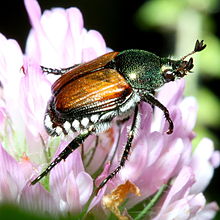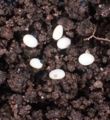Japanese beetle
| Japanese beetle | |
|---|---|

| |
Secure
| |
| Scientific classification | |
| Kingdom: | |
| Phylum: | |
| Class: | |
| Order: | |
| Suborder: | |
| Infraorder: | |
| Superfamily: | |
| Family: | |
| Subfamily: | |
| Tribe: | |
| Genus: | |
| Species: | P. japonica
|
| Binomial name | |
| Popillia japonica Newman, 1841
| |
The beetle species Popillia japonica is commonly known as the Japanese beetle. It is about 1.5 cm (0.6 inches) long and 1 cm (0.4 inches) wide, with iridescent copper-colored elytra and green thorax and head. It is not very destructive in Japan, where it is controlled by natural enemies, but in America it is a serious pest of about 200 species of plants, including rose bushes, grapes, canna, crape myrtles, and other plants.
It is a clumsy flier, dropping several centimeters when it hits a wall. Japanese beetle traps therefore consist of a pair of crossed walls with a bag underneath, and are baited with floral scent, pheromone, or both. However, studies done at the University of Kentucky suggest that traps attract more beetles than they actually trap, thus causing more damage than may have occurred were the trap not used.[1]
These insects damage plants by skeletonizing the foliage, that is, consuming only the leaf material between the veins.
History
As the name suggests, the Japanese beetle is native to Japan. The insect was first found in the United States in 1916 in a nursery near Riverton, New Jersey. It is thought that beetle larvae entered the United States in a shipment of iris bulbs prior to 1912 when inspections of commodities entering the country began.
Life cycle
-
A typical cluster of Japanese beetle eggs.
-
Japanese beetle larva.(Grub worm)
-
Japanese beetle pupa.
-
The Japanese beetle adult.
The life cycle of the beetle is typically one year in most parts of the United States, but this can be extended in cooler climates; for instance, in its native Japan, the beetle's life cycle is two years long as a result of the higher latitudes of the grasslands required for the larval stage. During the larval stage the white grubs can be identified by their V shaped raster pattern.
Control

During the larval stage, the Japanese beetle lives in lawns and other grasslands, where it eats the roots of grass. During that stage, it is susceptible to a fatal disease called milky spore disease, caused by a bacterium called milky spore, Paenibacillus (formerly Bacillus) popilliae. The USDA developed this biological control and it is commercially available in powder form for application to lawn areas. Standard applications (low density across a broad area) take from one to five years to establish maximal protection against larval survival (depending on climate), expanding through the soil through repeated rounds of infection, in-vers can be used to exclude the beetles, however this may necessitate hand pollination of flowers. Kaolin sprays can also be used as barriers.
Research performed by many US extension service branches has shown that pheromone traps may attract more beetles than they catch, and so they have fallen out of favor.[2] Natural repellents include catnip, chives, garlic, and tansy[3], as well as the remains of dead beetles. Additionally, when present in small numbers, the beetles may be manually controlled using a soap-water spray mixture.
Host Plants
Japanese Beetles feed on a large range of hosts, including leaves of plants of the following common crops:
Strawberries, tomatoes, peppers, grapes, hops, roses, plums, pears, peaches, raspberries, blackberries, corn, peas, blueberries
and these genera:
|
|
References
- ^ University of Kentucky Entomology, Managing Japanese Beetles
- ^ Japanese Beetle control strategies [1]
- ^ pests - selfsufficientish - pests
External links
- APHIS web page on beetle management
- Japanese beetle on the UF / IFAS Featured Creatures Web site




